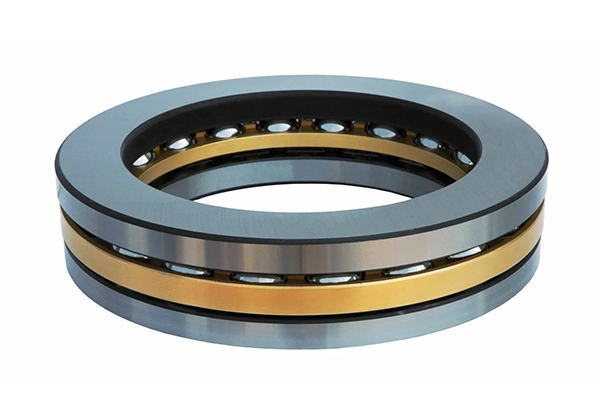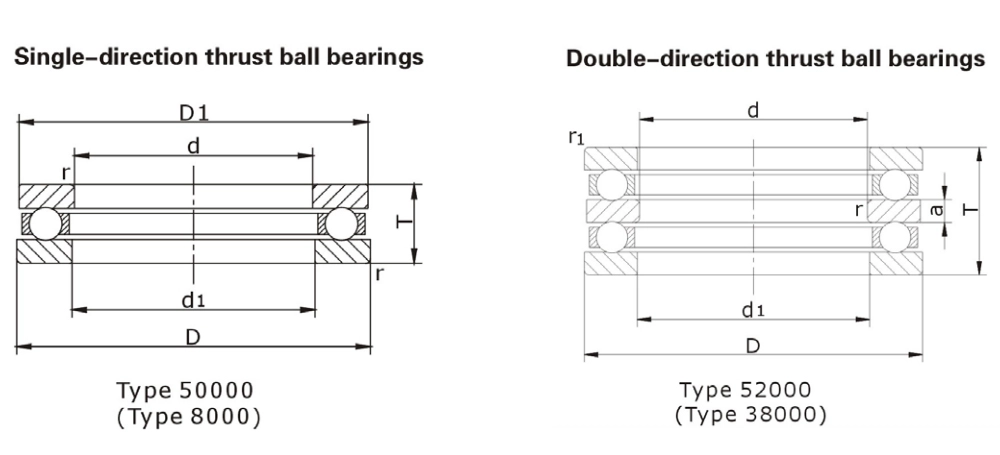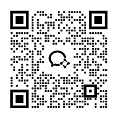What are the Common Problems With Single Row Thrust Ball Bearings?
Single row thrust ball bearings are critical components in various machinery applications, designed to handle axial loads and provide rotational support between two surfaces. Despite their robust design, these bearings frequently encounter a range of problems that can impact their performance and longevity. Understanding these common issues is essential for engineers, maintenance professionals, and equipment operators who rely on these components for smooth machinery operation. This article explores the most prevalent problems affecting single row thrust ball bearings and provides insights into their causes, prevention, and solutions.

How do premature failures occur in single row thrust ball bearings?
Excessive Loading Conditions
Premature failure of single row thrust ball bearings often stems from subjecting them to loads beyond their design specifications. When a single row thrust ball bearing experiences axial loads that exceed its rated capacity, the steel balls and raceways undergo accelerated wear and deformation. This excessive stress can manifest as indentations on the races, flattened balls, and cracking of components. The problem is particularly acute when the bearing experiences unexpected shock loads or when improper bearing selection results in undersized bearings for the application. Regular inspection for signs of overloading—such as abnormal noise, increased friction, or vibration—can help detect this problem before catastrophic failure occurs. Proper sizing and selection of single row thrust ball bearings based on accurate load calculations is essential to prevent premature failure due to excessive loading.
Contamination and Lubrication Issues
Contamination represents one of the most significant threats to single row thrust ball bearings. When foreign particles such as dust, dirt, metal chips, or water infiltrate the bearing assembly, they can cause abrasive wear on the balls and raceways. This contamination accelerates the deterioration of the single row thrust ball bearing surfaces, leading to increased friction, heat generation, and ultimately premature failure. Similarly, inadequate or improper lubrication creates conditions where metal-to-metal contact occurs, causing excessive friction and wear. The lubricant in single row thrust ball bearings serves not only to reduce friction but also to dissipate heat and protect against corrosion. Using the wrong type of lubricant, insufficient quantities, or failing to replenish degraded lubricant at appropriate intervals can significantly reduce bearing life. Implementing proper sealing systems, regular maintenance schedules, and appropriate lubrication practices is critical for preventing contamination-related failures.
Misalignment Problems
Misalignment occurs when the shaft and housing are not properly aligned, causing uneven load distribution across the single row thrust ball bearing. This misalignment creates localized stress concentrations that can lead to premature bearing failure through mechanisms such as edge loading and skewing. In single row thrust ball bearings, which are specifically designed to handle axial loads, misalignment can be particularly problematic as it introduces unintended radial forces. These additional forces can cause the balls to slide rather than roll, increasing friction and heat generation. Misalignment can result from improper installation, foundation settling, thermal expansion, or deflection under load. Regular alignment checks, proper installation procedures, and the use of appropriate mounting surfaces are essential practices for preventing misalignment problems in single row thrust ball bearings. In some cases, self-aligning designs may be considered for applications where misalignment is difficult to avoid.

What causes noise and vibration in single row thrust ball bearings?
Bearing Surface Damage
Surface damage on single row thrust ball bearings can manifest as spalling, pitting, or scoring, and is a primary contributor to noise and vibration issues. When the smooth surfaces of the races or balls become damaged, the bearing's operation becomes inconsistent, creating audible noise and detectable vibration patterns. This damage often begins microscopically but progresses rapidly once initiated. In single row thrust ball bearings, surface damage frequently originates from fatigue caused by repetitive stress cycles, particularly when the bearing operates near or beyond its design limits. The damage can also result from inadequate lubrication, which fails to maintain the essential fluid film between components. As the bearing's surface deteriorates, the resulting vibration not only affects machine performance but can accelerate damage to other machine components. Early detection through vibration analysis and regular visual inspections can identify surface damage before it progresses to catastrophic failure, allowing for timely replacement of affected single row thrust ball bearings.
Manufacturing Defects and Quality Issues
Manufacturing defects and quality inconsistencies in single row thrust ball bearings can lead to significant noise and vibration problems even in new installations. These defects may include dimensional inaccuracies, surface finish imperfections, or material inconsistencies that compromise the bearing's performance. Common manufacturing issues include out-of-round balls, inconsistent ball sizes, raceway irregularities, or improper heat treatment that affects material hardness. When single row thrust ball bearings contain such defects, they generate characteristic noise signatures and vibration patterns that can be identified through condition monitoring techniques. Sourcing bearings from reputable manufacturers with robust quality control processes is essential for minimizing these issues. Additionally, conducting receiving inspections and pre-installation testing can help identify defective components before they are installed in critical equipment, preventing unexpected downtime and additional damage to machinery using single row thrust ball bearings.

Improper Mounting and Installation Techniques
The manner in which single row thrust ball bearings are mounted and installed significantly impacts their noise and vibration characteristics. Improper installation techniques, such as using excessive force, applying force to the wrong bearing component, or using inappropriate tools, can damage the bearing before it enters service. When installing single row thrust ball bearings, technicians must ensure proper seating against the shaft shoulder or in the housing bore, appropriate preload application, and correct tightening of associated components. Installation errors often lead to abnormal running characteristics, including increased friction, uneven load distribution, and premature wear—all of which contribute to noise and vibration. Additionally, inadequate support structures or mounting surfaces that lack sufficient rigidity can amplify vibrations generated by the bearing. Proper training of maintenance personnel, following manufacturer-recommended installation procedures, and using appropriate installation tools specifically designed for single row thrust ball bearings are essential practices for minimizing installation-related noise and vibration problems.
How does temperature affect the performance of single row thrust ball bearings?
Thermal Expansion and Dimensional Changes
Temperature fluctuations significantly impact single row thrust ball bearings through thermal expansion and contraction of components. As temperatures rise, the bearing materials expand at different rates—steel races, balls, and cages each respond differently to temperature changes. These differential expansion rates can alter critical internal clearances within the single row thrust ball bearing, potentially leading to increased friction, reduced efficiency, and accelerated wear. In extreme cases, excessive thermal expansion can cause bearing seizure if clearances become too tight. Conversely, when operating temperatures fall, contraction can result in excessive internal clearance, leading to increased vibration and potential misalignment of the rolling elements. Engineers must account for these thermal effects when selecting and installing single row thrust ball bearings, especially in applications with wide temperature variations. Proper clearance specifications that accommodate the expected operating temperature range, along with appropriate material selection for thermal compatibility, can help mitigate problems associated with thermal expansion and dimensional changes in single row thrust ball bearings.
Lubrication Degradation at Extreme Temperatures
Temperature extremes pose significant challenges to the lubrication of single row thrust ball bearings. At high temperatures, lubricants can thin excessively, oxidize rapidly, or even carbonize, losing their protective properties. This degradation compromises the critical lubricant film that separates rolling elements from raceways in single row thrust ball bearings, leading to increased friction, wear, and potential seizure. Conversely, at low temperatures, lubricants may become too viscous, increasing starting torque and preventing proper distribution of the lubricant throughout the bearing. The reduced flow can leave critical areas of the bearing inadequately protected. Selecting appropriate lubricants specifically formulated for the operating temperature range of the application is essential for maintaining single row thrust ball bearing performance. Temperature-specific lubricants with appropriate additives, synthetic bases for extreme conditions, or specialized formulations may be necessary. Regular monitoring of lubricant condition and scheduled relubrication or replacement based on operating conditions rather than just time intervals can help maintain proper lubrication performance across temperature variations.
Heat Dissipation Challenges
Heat management represents a critical aspect of single row thrust ball bearing performance, particularly in high-speed or high-load applications. As these bearings operate, they generate heat through friction, and effective dissipation of this heat is essential for preventing thermal damage. When heat cannot efficiently escape from the bearing assembly, a dangerous cycle develops: increased temperature leads to lubricant degradation, which increases friction, generating more heat. This thermal runaway condition can rapidly lead to bearing failure. Single row thrust ball bearings face particular challenges in heat dissipation due to their design, which concentrates load along a single axial plane. Inadequate cooling mechanisms, restricted airflow around the bearing housing, or insufficient heat transfer through surrounding structures can exacerbate thermal problems. Implementing effective cooling solutions such as improved ventilation, oil circulation systems, or external cooling for the bearing housing can significantly improve heat dissipation. Additionally, monitoring bearing temperature during operation provides valuable data for predictive maintenance, allowing intervention before critical temperature thresholds are exceeded. Design considerations such as material selection for improved thermal conductivity and housing features that facilitate heat transfer can also enhance the thermal performance of single row thrust ball bearings.
Conclusion
Single row thrust ball bearings, despite their robust design, face various operational challenges including premature failures from overloading, contamination, and misalignment; noise and vibration issues stemming from surface damage, manufacturing defects, and improper installation; and performance problems related to temperature effects. Understanding these common issues enables more effective selection, installation, and maintenance practices, ultimately extending bearing life and improving machinery reliability. By implementing proper maintenance protocols and selecting appropriate bearings for specific applications, many of these common problems can be mitigated or avoided entirely.
Luoyang Huigong Bearing Technology Co., Ltd. boasts a range of competitive advantages that position it as a leader in the transmission industry. Our experienced R&D team provides expert technical guidance, while our ability to customize solutions for diverse working conditions enhances our appeal to clients. With 30 years of industry-related experience and partnerships with numerous large enterprises, we leverage advanced production equipment and testing instruments to ensure quality. Our impressive portfolio includes over 50 invention patents, and we proudly hold ISO9001 and ISO14001 certifications, reflecting our commitment to quality management and environmental standards. Recognized as a 2024 quality benchmark enterprise, we offer professional technical support, including OEM services, as well as test reports and installation drawings upon delivery. Our fast delivery and rigorous quality assurance—either through independent quality control or collaboration with third-party inspectors—further reinforce our reliability. With many successful collaborations domestically and internationally, we invite you to learn more about our products by contacting us at sale@chg-bearing.com or calling our hotline at +86-0379-65793878.
References
1. Johnson, K.L. (2022). "Contact Mechanics and Failure Analysis of Rolling Element Bearings." Journal of Tribology, 144(3), pp. 031701-031715.
2. Zhang, H. and Smith, R.W. (2023). "Thermal Effects on Thrust Ball Bearing Performance in Industrial Applications." Tribology International, 176, pp. 107848-107862.
3. Nakajima, K. and Anderson, P. (2021). "Contamination Mechanisms and Their Impact on Single Row Thrust Ball Bearing Life." Wear, 482-483, pp. 203989-204001.
4. Miller, F. and Thompson, L. (2023). "Vibration Analysis Techniques for Early Detection of Thrust Bearing Failures." Mechanical Systems and Signal Processing, 180, pp. 109408-109422.
5. Chen, W. and Garcia, D. (2022). "Advances in Lubricant Technology for Extended Thrust Ball Bearing Service Life." Tribology Transactions, 65(4), pp. 673-687.
6. Patel, S. and Williams, J. (2024). "Comparative Study of Installation Methods and Their Effect on Thrust Ball Bearing Performance." International Journal of Precision Engineering and Manufacturing, 25(1), pp. 121-135.

